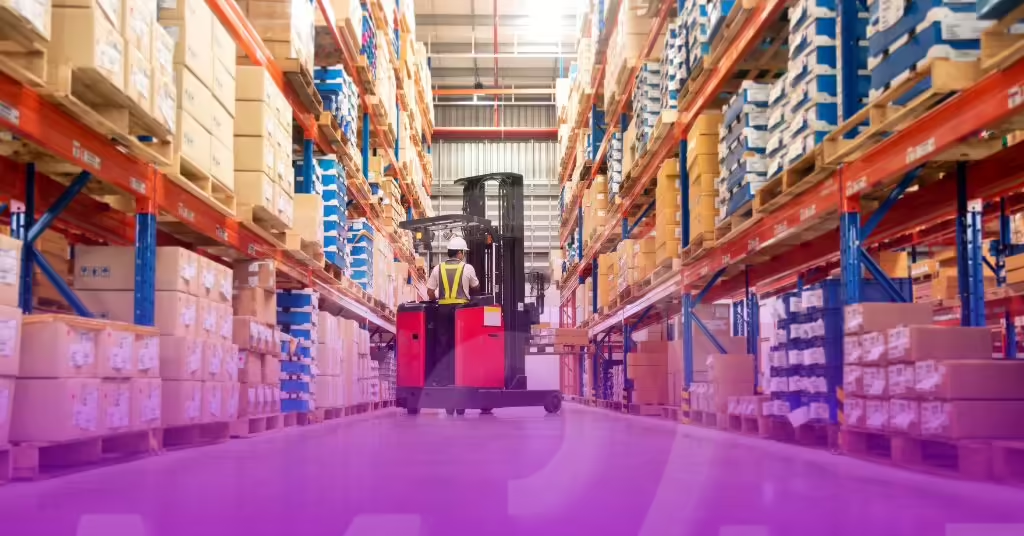يشير مصطلح مراقبة جودة المستودعات إلى مجموعة العمليات التي يقوم بها المستودع لضمان أن المخزون المخزن يفي بمعايير الصناعة. ويركز على فحص المنتجات بحثًا عن التلف، وتقييم اتساق جودة المنتج، وضمان مغادرة الشحنات للمستودع في حالة جيدة.
بدون وجود سير عمل لمراقبة جودة المستودعات، عمليات تنفيذ الطلبات يمكن أن تتحول الأمور بسرعة إلى فوضى. يؤدي حساب المخزون بشكل غير صحيح إلى نفاد المخزون أو زيادة المخزون. قد تتسرب البضائع التالفة أو المعيبة دون أن يلاحظها أحد، مما يؤدي إلى شكاوى العملاء وإرجاعها وإلحاق الضرر بسمعتها.
قد يؤدي شحن المنتجات/الكميات الخاطئة أو وضع العلامات الخاطئة عليها إلى حدوث تناقضات غير ضرورية في الشحنة نهاية الناقل وبالتالي، فإن عدم الثقة في ممارساتك التجارية قد يؤدي إلى زيادة التكاليف غير الضرورية التي قد تتكبدها إذا لم تكن هناك إجراءات تشغيلية قياسية للتعامل مع المواد الخطرة بأمان.
لماذا تعتبر مراقبة جودة المستودعات مهمة؟
باختصار، تعد مراقبة جودة المستودعات مهمة لأنها تساعد في الحفاظ على سلامة وجودة العناصر المخزنة، وكلاهما ضروري لإرضاء العملاء. فيما يلي بعض الأسباب التي تجعلك تنفذ تدابير مراقبة الجودة المناسبة في مستودعك.
الامتثال التنظيمي
تضمن مراقبة الجودة امتثال الشركات لمعايير الصناعة واللوائح القانونية. وقد يؤدي عدم القيام بذلك إلى سحب المنتجات أو رفع دعاوى قضائية أو فرض غرامات. يساعد الالتزام الشركات على تجنب التعرض القانوني والمخاطر المالية والتقاضي المحتمل.
توفير التكاليف
قد يكون التخلص من المنتجات ذات الجودة الرديئة أو إعادة تصنيعها مكلفًا للغاية. في بعض الأحيان، قد يتعرض العملاء أيضًا لإصابات جسدية بسبب العناصر المعيبة ويقدمون دعوى مسؤولية ضدك، وهو ما قد يكون مكلفًا للغاية أيضًا. احرص على إجراء مراقبة شاملة لجودة المستودعات ووفر كل هذه الأموال.
رضا العملاء
يضمن سير عمل مراقبة الجودة المتين أن منتجاتك تلبي دائمًا توقعات العملاء أو تتجاوزها. الجودة الثابتة هي طريقة أكيدة لبناء ثقة العملاء، وتعزيز معدلات التحويل، وتشجيع الولاء على المدى الطويل.
سمعة العلامة التجارية
ترتبط جودة المنتج بشكل مباشر بسمعة العلامة التجارية. فمن المرجح أن يشتري العملاء من الشركات المعروفة بتمسكها بمعايير الجودة العالية. وتعمل عمليات مراقبة الجودة مثل عمليات التفتيش المبكرة في سلسلة التوريد على منع المنتجات المعيبة من التداول وحماية مصداقية علامتك التجارية.
مراقبة جودة المستودعات مقابل ضمان جودة المستودعات: ما هو الفرق؟
على الرغم من أن كلا المصطلحين يركزان على تقييم أداء المستودع، إلا أن مراقبة الجودة وضمان الجودة يخدمان غرضين مختلفين.
يقوم قسم مراقبة الجودة بالمستودعات بفحص وتقييم المنتجات على مستوى الدفعة للتأكد من تخزينها وتعبئتها وفقًا لمعايير الجودة قبل شحنها. على سبيل المثال، إذا تم تجهيز 100 منصة نقالة للشحن، يقوم قسم مراقبة الجودة بفحص المجموعة كدفعة وفحصها للتأكد من أن جميع العناصر تطابق الحجم والشكل واللون المطلوب وما إلى ذلك. إذا كانت إحدى المنصات تحتوي على عناصر معيبة، يتم وضع علامة عليها كمشكلة جودة ضمن تلك الدفعة.
من ناحية أخرى، يركز ضمان جودة المستودعات على تحسين العمليات في جميع أنحاء المستودع لمنع حدوث العيوب في المقام الأول. ويضمن أن كل خطوة، سواء كانت متعلقة بالتخزين أو المناولة أو التعبئة والتغليف، تتم وفقًا لمعايير محددة مسبقًا. وبدلاً من فحص الدفعات، يعمل ضمان الجودة على القضاء على المخاطر في جميع العمليات. على سبيل المثال، إذا قمت بتنظيم برامج تدريبية لموظفي المستودعات حول التعامل السليم مع العناصر الهشة لتقليل الكسر أثناء التخزين أو النقل، فسيكون ذلك جزءًا من استراتيجية ضمان الجودة الخاصة بك.
باختصار، تعمل مراقبة جودة المستودعات على تحديد المشكلات في الدفعات النهائية، بحيث يتم شحن المنتجات المطابقة فقط وتسليمها إلى العميل النهائي. وفي الوقت نفسه، تعمل ضمان جودة المستودعات على دمج التدابير الوقائية في العمليات اليومية لتحقيق تحسينات طويلة الأجل. وعند استخدام هاتين العمليتين معًا، تساعد كل منهما في الحفاظ على جودة المنتج وتحسين كفاءة سير العمل.
التحديات الشائعة في مراقبة جودة المستودعات
جودة المنتج غير متناسقة
غالبًا ما يكون من الصعب الحفاظ على معايير الجودة موحدة في جميع المخزونات. ويرجع هذا بشكل أساسي إلى أن المنتجات التي يتم استلامها من موردين مختلفين أو دفعات إنتاج مختلفة قد تختلف في الجودة.
مثال: تحتوي دفعة الملابس من أحد الموردين على عيوب في الخياطة، ولكن دفعة أخرى من مورد مختلف تتميز بجودة ممتازة.
حل: تنفيذ عمليات تدقيق الموردين ومعايير الجودة لضمان الاتساق في جميع الشحنات.
الأخطاء البشرية في التفتيش
رغم أن الفحص اليدوي ضروري، إلا أنه لا يزال عرضة للأخطاء. ومن الممكن أن يتجاهل موظفوك عيبًا ما أو يخطئون في تقديره عن غير قصد.
مثال: يغفل أحد العمال عن الخدوش الموجودة على منصة نقالة تحتوي على إلكترونيات أثناء نوبة عمل مزدحمة. يطلب العميل إرجاع المنتج عند استلامه.
حل: استخدم ماسحات الباركود وقوائم المراجعة وأدوات مراقبة الجودة الآلية لتقليل الاعتماد على عمليات التفتيش اليدوية.
القيود الزمنية خلال مواسم الذروة
يرتفع الطلب من قبل العملاء بشكل كبير خلال مواسم الذروة، ولا يكاد يكون هناك وقت كافٍ لفحص كل منتج من الداخل والخارج. ونتيجة لذلك، يتم تسليم الشحنات على عجل دون إجراء فحوصات الجودة الكافية.
مثال: خلال فترة عيد الميلاد، يقوم المستودع بتجهيز الطلبات بسرعة لضمان التسليم في الوقت المناسب. تصل الطلبات إلى العملاء، وغالبًا ما تكون بها مشكلات في التعبئة أو عناصر مفقودة.
حل: استخدم أساليب أخذ العينات العشوائية وتعزيز فرق الجودة خلال فترات الطلب المرتفع للحفاظ على معايير التفتيش.
ظروف تخزين سيئة
يمكن أن تؤدي بيئات التخزين غير المناسبة إلى التأثير سلبًا على جودة المنتجات، وخاصة تلك التي تتطلب مستويات معينة من الحرارة أو الرطوبة.
مثال: يقوم فريق التخزين الخاص بك بتخزين الشوكولاتة في منطقة غير خاضعة للتحكم في درجة الحرارة. فهي تذوب وتفقد سلامتها البنيوية.
حل: قم بتثبيت أنظمة التحكم في المناخ وأدوات المراقبة في الوقت الفعلي لضمان الظروف المناسبة للمنتجات الحساسة.
إجراءات الجودة غير المتسقة عبر التحولات
في المستودعات العادية، يحدث عادة أن تكون هناك مهام مختلفة لنوبات عمل مختلفة لضمان توزيع عادل ومنصف لحجم العمل. ونتيجة لذلك، تصبح المعايير غير المتسقة أمرًا لا مفر منه، وتزداد احتمالات عدم اكتشاف العيوب.
مثال: قد يقوم فريق العمل الصباحي بفحص العينات، بينما يقوم فريق العمل الليلي بفحص ملصقات المنتجات فقط.
حل: تطوير إجراءات التشغيل القياسية وإجراء تدريب منتظم للموظفين لضمان الاتساق في جميع التحولات.
عدم امتثال المورد
قد لا يلتزم الموردون دائمًا بمعايير الجودة المتفق عليها ويرسلون المنتجات المعيبة إلى المستودع. يؤدي تحديد هذه المشكلات في وقت متأخر إلى تعقيد إرجاع المنتجات وتنفيذ الطلبات.
مثال: يقوم أحد الموردين بتسليم دفعة من الأثاث بها مسامير مفقودة، وهو ما يتم اكتشافه فقط بعد وصول المنتج إلى العملاء.
حل: إنشاء اتفاقيات الجودة مع الموردين وإجراء عمليات تدقيق منتظمة لضمان الامتثال.
تكاليف عالية بسبب الإرجاع وإعادة العمل
إن شحن منتج معيب يعني دائمًا تقريبًا تكلفة مالية وتشغيلية إضافية لإدارة الخدمات اللوجستية العكسية الخاصة به.
مثال: يقوم العملاء بإرجاع مجموعة من الهواتف الذكية المعيبة ويطلبون الإصلاح أو الاستبدال.
حل: تنفيذ عمليات فحص الجودة متعددة المراحل للكشف عن العيوب في وقت مبكر وتقليل تكاليف إعادة العمل.
6 أفضل الممارسات لمراقبة جودة المستودعات
فيما يلي ستة أفضل الممارسات التي ستساعد مستودعاتك على زيادة دقة التشغيل ورضا العملاء.
1. تحديد أهداف واضحة لمراقبة الجودة
ابدأ بتحديد أهداف قابلة للقياس تتوافق مع أهداف عملك. قد تتضمن هذه الأهداف دقة الشحن المستهدفة، أو تقليل البضائع التالفة، أو الالتزام بمواعيد التسليم. توفر ال��هداف الواضحة الاتجاه وتسمح لك بتتبع التقدم بشكل فعال.
نصيحة احترافية: استخدم مؤشرات الأداء الرئيسية مثل دقة الطلب ومعدل الضرر وتكرار الإرجاع لمراقبة عملياتك.
2. إنشاء واتباع إجراءات التشغيل القياسية (SOPs)
تقلل الإجراءات التشغيلية القياسية الموثقة جيدًا من الأخطاء البشرية وتضمن تدفقًا سلسًا للعمليات باستمرار. تحدد هذه الإجراءات تعليمات محددة لجميع العمليات الرئيسية المشاركة في سير عمل إدارة المستودعاتمن الاستلام الوارد إلى الخدمات اللوجستية العكسية.
نصيحة احترافية: تحديث الإجراءات التشغيلية القياسية بانتظام لتعكس تغييرات الصناعة أو تقديم أفضل الممارسات الجديدة.
3. فحص المنتجات على دفعات
بدلاً من مراجعة كل عنصر على حدة، قم بفحصه على دفعات. سيسمح هذا بمراقبة الجودة بكفاءة دون التضحية بالدقة. يساعد أخذ العينات العشوائية أيضًا في اكتشاف العيوب قبل وصول الشحنة إلى العملاء. على سبيل المثال، يمكنك فحص 100 وحدة عشوائيًا في دفعة مكونة من 1000 عنصر. إذا وجدت أي مشكلات في العينة، فيمكنك إرسال الدفعة بأكملها لمزيد من التدقيق.
نصيحة احترافية: يقدم أخذ العينات القبولية خطط لوضع حدود واضحة لمستويات العيوب المقبولة.
4. إجراء عمليات تدقيق روتينية
بالإضافة إلى ضمان الامتثال لسياسات الشركة والمعايير التنظيمية، فإن عمليات التدقيق المنتظمة ستساعدك على تحديد الاختناقات وتسليط الضوء على المجالات التي تحتاج إلى تحسين. على سبيل المثال، ��د يكشف تدقيق الجودة عن تلف بعض السلع الحساسة للحرارة لأن قسمًا من المستودع يفتقر إلى التهوية المناسبة.
نصيحة احترافية: جدولة عمليات التفتيش المفاجئة للتأكد من أن الموظفين يتبعون الإجراءات أم لا.
5. مراقبة العمليات اليومية
تتبع الأداء اليومي لتتمكن من الاستجابة بسرعة للاتجاهات أو المشكلات المتكررة. على سبيل المثال، إذا قام مدير المستودع الخاص بك بمراجعة تقارير دقة الطلبات اليومية ولاحظ خطأ متكررًا في إحدى الورديات، فيمكنه تعديل الموظفين وإعادة تدريب الوردية لحل المشكلة على الفور.
نصيحة احترافية: استخدم لوحات المعلومات لتوضيح البيانات وتزويد الفرق بملاحظات في الوقت الفعلي حول أدائها.
6. فكر في أتمتة المستودعات
استثمر في نظام إدارة المستودعات (WMS)، وهو نوع متخصص من برامج إدارة المخزون التي تعمل على تبسيط حركة البضائع داخل وخارج المستودعات. تتضمن بعض حلول WMS أيضًا مسح الباركود وتتبع RFID وأدوات متقدمة أخرى من أجل:
- أتمتة فحص البضائع الواردة.
- وضع خطة لتحسين تخطيط المستودعات.
- مراقبة مستويات المخزون والمواقع.
- ضمان دقة اختيار الطلبات.
- تحديث المخزون مع دخول العناصر إلى المستودع وخروجها منه.
- إجراء عمليات تدقيق المخزون بشكل منتظم.
- تتبع حركة المنتج بعد الشحن.
- إدارة الإرجاعات والتبادلات بسلاسة.
نصيحة احترافية: تنفيذ نظام إدارة المستودعات الخاص بـ Mile.
جدولة عرض توضيحي اليوم لمعرفة المزيد عن Mile وحلول WMS القوية لدينا.


